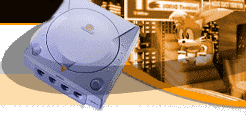| |
Armada
Asteroids + RPG = Fun? - Review By Fragmaster
 Back in the early 80's, some of the best, most popular videogames around were 2D space shooters. Games like Galaga, Galaxian, Space Invaders, and Asteroid ruled the arcades, sucking up quarters almost as fast as the U.S. mint could produce them. The space shooter sub-genre continued to evolve throughout the 80's and into the 90's, resulting in games like the Thunderforce, R-Type, and Gradius series. As an aside, if you're interested in games like these, you should check out Shmups!, a great site dedicated to showcasing some of the best (and worst) 2D shooters ever made. Back in the early 80's, some of the best, most popular videogames around were 2D space shooters. Games like Galaga, Galaxian, Space Invaders, and Asteroid ruled the arcades, sucking up quarters almost as fast as the U.S. mint could produce them. The space shooter sub-genre continued to evolve throughout the 80's and into the 90's, resulting in games like the Thunderforce, R-Type, and Gradius series. As an aside, if you're interested in games like these, you should check out Shmups!, a great site dedicated to showcasing some of the best (and worst) 2D shooters ever made.
Which brings us to Armada.
Armada was originally scheduled to be a launch title, and was almost universally overlooked and even snickered at. While Armada uses 3D rendered graphics, the 2D gameplay will be immediately familiar to anyone who has ever touched Asteroids or one of its many clones. A 2D space shoot 'em up in the age of Soul Calibur? How could a game like that possibly stand out amidst the Dreamcast's hottest games? Sure, the back of the jewel case touts four player cooperative gameplay and a huge "action-RPG world" with hundreds of enemies, but come on: Asteroids, the multiplayer RPG? Who in their right mind would buy a game like that?
The answer may surprise you.
The Good
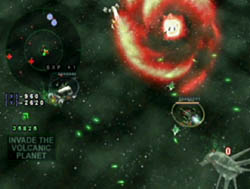
Armada is an action\RPG that involves shooting stuff up. Yay, explosions! |
The story behind Armada goes something like this: humans realize that Earth will eventually be toast and begin to colonize all over the universe. About 10,000 years after settling throughout space, humans began to adapt to their new surroundings, resulting in different variations or "tribes" of humans. The human race as a whole started to drift apart, and during that period a biomechanical Armada noticed the human tribes on Earth and began to wage war on them for apparently no reason other than conquest. Eventually the remaining fractions of human tribes decided to band together and formed the Allied Command. You, Nameless J. Fighter Pilot (ok, so I made that name up) are a starship captain in this bold new era, and your mission is to win the freedom of the human race by either destroying the Armada or establishing contact with it. And as we all learned from the movie Independence Day, the best way to communicate with aliens is to shoot up their ships with missiles.
While the story won't win any awards, it actually does affect the game in a positive way. Since the game is a self-described action-RPG (more on how that works later), some sort of reason for doing what you're doing is pretty essential. While Armada is far from epic, the interactions between the various races of humans, as well as seeing your reputation among high-ranking members of the Allied Command change throughout can be interesting.
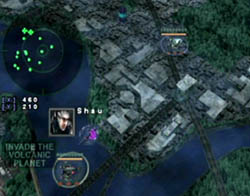
Your home planet. Here you can chat it up with your comrades, get missions, and recharge your ship. |
When you start the game, you'll need to choose what race of human you'll be. There are six difference races, each with their own strengths and weaknesses. You start the game in a city on the only civilized planet the Alliance controls. There, you can talk with other members of the Alliance who are flying their ships around with the aid of your scanner. Most of these other captains will instead offer advise or background information, but two of these ships, the Phoenix and Lola, will provide you with power pods and armor repairs. Returning back to the home planet is essential for recharging your batteries and procuring those hard to find power pods. While it's easy to find your way back due to its coordinates (it's 0,0), there's also a handy "return home" option you can engage whenever you pause the game. I didn't discover that feature until I reached level 8, doh! That, along with the excellent map system, makes it pretty much impossible to get lost.
Once you take off into space, the real game begins. Basic gameplay goes a little something like this: when you kill an Armada ship, you'll gain experience. You can also salvage credits, or money, from the wreckage. Once you get enough experience, you'll advance a level and gain power and/or a ship upgrade. Credits can be used to upgrade your ship with advanced technology obtained at starbases scattered throughout space. Of course, you don't spend the entire game running around blowing up ships. Allied Command will provide you with missions, which range from delivering supplies to a remote outpost to destroying a dangerous Armada ship. Once you've received a mission, it shows up on the left side of your screen along with an indicator pointing out the direction and distance to your objective. These missions can be difficult to complete. Sometimes you just won't be powerful enough to achieve your objective at first. Luckily, there are "mini-missions" of sorts you can play at anytime. Most of these involve answering distress signals and escorting or assisting Allied ships to their intended destinations. Upon safe arrival, you'll earn a hefty credit bounty for your trouble, which you can use for upgrades. Once you complete a mission, you'll be assigned a new one upon return to the Allied planet.
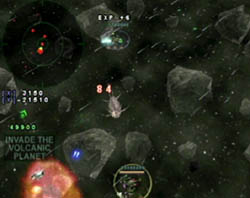
Metro3D managed to keep space looking interesting, thanks to multiple layers of graphics, debris, and galaxy-type thingies. |
One odd thing Armada does, which is very unusual, is that it doesn't punish you for dying. You have three lives (you die when your armor runs out), but once you lose them all up you are just warped back to your home planet. You don't lose any experience, credits, or equipment whatsoever. This encourages exploration and experimentation, since if you die on a mission or while scouting a new section of space, the only thing you lose is the amount of time it'll take you to fly back there. This also lowers the frustration factor, since you'll never have to wait for a new game to load. Those of you that reload a saved game every time something bad happens knows how annoying that can be. The difficulty level is just about perfect, partly because of the way the game handles kills and partly due to the way the missions are designed to be tougher than you can handle (in most cases) initially.
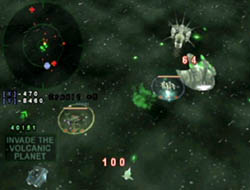
Escort or protection missions are always pretty easy to find and a great way to build up cash and experience if you can't beat your current assignment. |
Controlling your ship throughout the seemingly limitless expanses of space is pretty easy. The analog stick is used to control your ship's direction, and the D-Pad is used to control decent and ascent from planet surfaces or starbases. The right trigger is thrust, while the left trigger activates the more powerful warp engine, which makes long trips a lot more convenient. The A-Button fires your main weapon, and the B-Button is used for activating your powerpod attack. Powerpods are usually obtained from Phoenix on the Allied planet. The powerpod attack discharges a tremendous ball of energy around your ship, inflicting damage on all enemy ships around you. You can also use powerpods to recharge your ship's armor by pressing the Y-Button. The X-Button activates your scanner, which is used for talking to Allied ships, identifying the level and condition of enemy ships, or to assist you in the collection of items from destroyed Armada ships.
Taking on the mighty Armada alone is a pretty tall order, but thanks to the game's nifty multiplayer mode, you and up to three of your friends can take 'em on together. Believe it or not, the four-player gameplay works almost flawlessly. Since up to six characters and four campaigns can be stored on a single VMU there's plenty of room for multiple adventures, and it's easy for friends to bring over their characters.
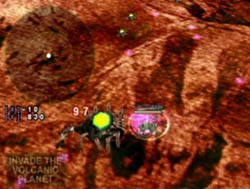
The mission objectives can be quite nasty, this guy just doesn't want to go down. |
The graphics won't take your breath away, but they're more than good enough. There are a good variety of enemies and ships, and even though the game takes place largely in the cold black vacuum of space, it still looks pretty damn good. When you're flying through space, it actually looks as if you're going somewhere thanks to the multiple layers of graphics and cool "warp" effects.
The interface isn't exactly pretty, but it works like a charm and makes it easy to setup and play any type of game. The autosave is a nice touch, too. Unless you're a total idiot, you'll never have to deal with losing your hard earned progress. The sound and music are above average across the board. While I wouldn't call the musical score brilliant, it can be pretty nice and I can't recall hearing anything remotely annoying. The sound effects are well produced and add incredibly to the atmosphere. The voice acting is solid and professionally done, with only a few small exceptions.
The Bad
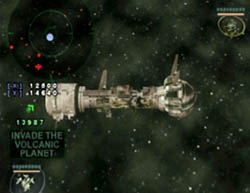
Starbases allow you to upgrade your ship... if you show 'em the money. |
Welp, let's see here� the controls could be a bit tighter, more precise, but with practice you shouldn't have much of a problem. Flying your ship around is very frustrating at first, but if you stick with it you'll only swear every fifteen minutes or so.
There is a small learning curve, this isn't a game you can pop in and play immediately. To help combat the inevitable initial confusion, be sure to read the manual and pay attention to what's being displayed on the in-game interface. There are also points in the game where you'll say "dammit, completing this mission is impossible!" but believe me, it's not. You may have to level up or buy some new equipment, but eventually you'll find a way to come out victorious. Oh yeah, the manual: it just isn't as good as it should be. There are a lot of things about the game that really should be in there, such as information on the inventory system. You can only use four things at a time, but since you can buy more than four upgrades you may keep on buying upgrades and then wonder why you're not doing any better.
Since you spend most of your time shooting stuff, some people may find the action repetitive after awhile. I didn't, but I must admit that I did suffer from a mild case of Sega thumb.
Besides that, there's some minor glitches that occasionally pop up, such as getting stuck in other enemy ships and loading delays or skipping. Again, these are rare, and you may not even encounter these problems, but they're there. The fact that the game doesn't tell you how much more experience you need to get to the next level can be annoying, and the opening cinematic is kinda lame, but� oh well.
The Final Word
I'm really surprised by Armada. After playing it initially for only a few minutes without reading the entire manual, I dreaded the thought of having to play yet another mediocre game. But with time, after learning how to play and figuring out what the hell was going on, I slowly began to really enjoy it. At one point, after winning an intense battle with a particularly nasty enemy bad-ass and escaping by the skin of my teeth, I felt strangely satisfied, and dare I say, excited (no, not in that way). As a guy who basically plays games as a living, I can tell you that doesn't happen often. When I flew back to Allied Command and received a hero's welcome from the other members of the alliance, as well as a ship upgrade, I felt as if I had actually accomplished something. Then I realized I had been playing for almost four hours straight and had to drag myself away. Armada is definitely worth at least renting and is a must have if you're looking for a great multiplayer game to play with friends. Armada is well designed, original, surprisingly deep, and one hell of an engaging game. Highly recommended.
Developer: Metro3D
Publisher: Metro3D
Genre: Action
Highs: Great gameplay, depth, and design.
Lows: Controls could be tighter, poor instructions, some may find it too repetitive.
Other: 1-4 players, VMU Compatible.
|
Final Score:

(out of a possible 10)
|
Visit this Game's Dreamcast Database Entry
Previous Reviews
Comments on this review? Mail Feedback.
|

